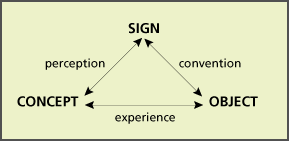

In semiotics, a sign is defined as, "...something that stands for something else, to someone in some capacity." (Marcel Danesi and Paul Perron, "Analyzing Cultures".) It may be understood as a discrete unit of meaning, and includes words, images, gestures, scents, tastes, textures, sounds — essentially all of the ways in which information can be communicated as a message by any sentient, reasoning mind to another.
The nature of signs has long been discussed in philosophy. Initially, within linguistics and later semiotics, there were two general schools of thought: those who proposed that signs are dyadic, and those who proposed that signs are interpreted in a recursive pattern of triadic relationships.
Dyadic signs
Charles Peirce (1839-1914) proposed a different theory. Unlike Saussure who approached the conceptual question from a study of linguistics and phonology, Peirce was a Kantian philosopher who distinguishes "sign" from "word", and characterizes it as the mechanism for creating understanding. The result is not a theory of language, but a theory for the production of meaning that rejects the idea of a stable relationship between a signifier and its signified. Rather, Peirce believed that signs establish meaning through recursive relationships that arise in sets of three. The first three distinct components he identifies were:
Peirce explained that signs mediate the relationship between their objects and their interpretants in a triadic mental process. Firstness is a general state of mind in which there is awareness of the environment, a prevailing emotion, and a sense of the possibilities. This is the mind in neutral, waiting to formulate thought. Secondness moves from possibility to greater certainty shown by action, reaction, causality, or reality. Here the mind identifies what message is to be communicated. Thirdness is the mode of signs shown in representation, continuity, order, and unity. The signs thought most likely to convey the intended meaning are selected and the communication process is initiated. This will involve either interpersonal behaviour using nonverbal systems to supplement verbal meaning through intonation, facial expression, or gesture, or as in the exercise of producing this page, the writing and iterative editing process to arrive at the final selection of words now appearing.
This process is reversed in the receiver. The neutral mind acquires the sign. It recovers from memory the object normally associated with the sign and this produces the interpretant. This is the experience of intelligibility or the result of an act of signification (not necessarily as the signified in the sense intended by Saussure). When the second sign is considered, the initial interpretant may be confirmed, or new possible meanings may be identified. As each new sign is addressed, more interpretants may emerge.
But, Peirce also refers to the ''ground'' of a sign. This is the idea or principle which determines how the sign represents its object, e.g. as in literal and figurative language. The triadic relation between the ground, object, and interpretant of a sign may have its own signification, which may produce another triadic relation between the relation itself, its signfication, and the interpretation of that signification. Hence, as phrased by Jean-Jacques Nattiez (1990: 7), "the process of referring effected by the sign is infinite."
According to Gilles-Gaston Granger (1968: 114), Peirce's representamen is, "...a thing which is connected in a certain way to a second sign, its 'object', in such a way that it brings a third sign, its 'interpretant,' into a relationship with the same 'object,' and this in such a way that it brings a fourth sign into a relationship with this same 'object,' and so on ad infinitum."
According to Nattiez, writing with Jean Molino, this tripartite definition is based on the "trace" or neutral level, Saussure's "sound-image" (or "signified", thus Peirce's "representamen"). Thus, "a symbolic form...is not some 'intermediary' in a process of 'communication' that transmits the meaning intended by the author to the audience; it is instead the result of a complex process of creation (the poietic process) that has to do with the form as well as the content of the work; it is also the point of departure for a complex process of reception (the esthesic process that reconstructs a 'message'"). (ibid, p.17)
Molino and Nattiez's diagram:
| Poietic Process | Esthesic Process | |||
| "Producer" | → | Trace | ← | Receiver |
- (Nattiez 1990, p. 17)
Peirce's theory of the sign therefore offered a powerful analysis of the signification system and its codes because the focus was on the cultural context rather than linguistics which only analyses usage in slow-time whereas, in the real world, there is an often chaotic blur of language and signal exchange during human semiotic interaction. Nevertheless, the implication that triadic relations would cycle "infinitely" leads to a level of complexity not usually experienced in the routine of message creation and interpretation. Hence, different ways of expressing the idea have been developed.
object: anything that can be thought, whether as a concept or thing, so long as it is capable of being encoded in a sign;
representamen: the sign that denotes the object (cf. Saussure's "signifier"); and
interpretant: the meaning obtained by decoding or interpreting the sign which may be:
- immediate, i.e. the denotative meaning,
dynamical, i.e. the meaning actually produced by the sign, or
final, i.e. the meaning that would be produced if the sign were properly understood.
- immediate, i.e. the denotative meaning,
- (Nattiez 1990, p. 17)
No comments:
Post a Comment